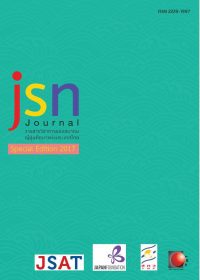Learning Management from Activities in Japanese Mathematics Book to Promote Analytical Thinking Skills of Prathomsuksa 6 Students by Open Approach Method
Main Article Content
Abstract
The purpose of this research was to; (1) Promote of an analysis thinking skills of Prathomsuksa 6 students (2) Study the students’ learning satisfaction with teaching and learning in Mathematics by using the Activities in Japanese mathematics textbooks. The population in this study are 30 students in Prathomsuksa 6 studying in Bankonglom school, in the B.E. 2559 (2016) academic year. This study was a descriptive research design. The method of the data analysis included the average and the standard deviation. The research instruments were the lesson plan, the teacher’s observation log, the thinking skills test, and the satisfaction test.
The results of the research are as follows: 1. the activities in the Japanese mathematics textbooks can promote Prathomsuksa 6 students’ critical thinking skills Discrimination: The first step is the posing open-ended problem by Teachers use questions to motivate students to solve problems. Classification: The second step is students’ self-learning by Students within the group discuss solutions from similar and similar approaches and bring them to a conclusion. Connection: The third step is the whole-class discussion and comparison by students’ link solutions to problems of similar groups. Summary and application aspects: The final is the summary through connecting students’ mathematical ideas emerged in the classroom by Teachers and students jointly outline solutions to problems, problems in that period, and other predictable approaches. 2. The students were very satisfied with mathematics learning activities used in the mathematics books. The use of teaching materials for activities was at the very good level. Secondly, the students’ participation in the group activities and the classroom atmosphere were at the good level.
Article Details
ข้อความและข้อคิดเห็นต่างๆ ในบทความเป็นของผู้เขียนบทความนั้นๆ ไม่ใช่ความเห็นของกองบรรณาธิการหรือของวารสาร jsn Journal
References
กระทรวงศึกษาธิการ. (2544). หลักสูตรการศึกษาขั้นพื้นฐานพุทธศักราช 2544. กรุงเทพฯ: โรงพิมพ์คุรุสภาลาดพร้าว.
กระทรวงศึกษาธิการ. (2556, 15 มีนาคม). นโยบายการศึกษารัฐมนตรีว่าการกระทรวงศึกษาธิการ. เข้าถึงได้จาก http://www.moe.go.th/moe/upload/
ประพันธ์ศิริ สุเสารัจ. (2551). การพัฒนาการคิด. กรุงเทพฯ: โรงพิมพ์ 9119 เทคนิคพริ้นติ้ง.
ปิ่นแก้ว ไชยสลี (มปป). การขาดทักษะการคิดวิเคราะห์ (Lack of Critical Thinking). เข้าถึงได้จาก http://mcpswis.mcp.ac.th/html_edu/cgi-bin/mcp/main_php/print_informed.php?id_count_inform=17030
รัตนา สิงหกูล. (2550). ผลการสอดแทรกกิจกรรมการฝึกทักษะการคิดขั้นพื้นฐานในการสอนที่มีต่อความสามารถในการคิดวิเคราะห์ของนักเรียนชั้นประถมศึกษาปีที่ 1. ปริญญาครุศาสตรมหาบัณทิต, สาขาหลักสูตรและการสอน, มหาวิทยาลัยราชภัฏลำปาง.
ลักขณา สริวัฒน์. (2549). การคิด=Thinking. กรุงเทพฯ: โอเดียนสโตร์.
วุฒิชัย ไพคำนาม, วรรณิภา ศุกรียพงศ์, สมจินต์ ศรีเมือง, ประกายฝน บรรดาศักดิ์ไพศาล และนเรียนนามบุญเรือง. (2555). การศึกษาความสามารถในการคิดวิเคราะห์ของนักเรียนชั้นประถมศึกษาปีที่ 4 โรงเรียนสาธิต มหาวิทยาลัยขอนแก่น ฝ่ายประถม. เข้าถึงได้จาก http://www.primary.satit.kku.ac.th/main/administrator/modules/mod_fileresearch/myfile/20131210145003_05satitJurnal_pwutti.pdf.
ศิริชัย กาญจนวาสี และคณะ. (2551). เอกสารประกอบการประชุมปฏิบัติการเพื่อพัฒนาแบบวัดการคิดจำแนกตามกลุ่มสาระการเรียนรู้สำหรับ 4 ช่วงชั้น ภายใต้โครงการขับเคลื่อนการคิดสู่ห้องเรียน. กรุงเทพฯ: ศูนย์ทดสอบและประเมินเพื่อพัฒนาการศึกษาและวิชาชีพ คณะครุศาสตร์ จุฬาลงกรณ์มหาวิทยาลัย.
สิริกาญจน์ ธนวุฒิพรพินิต. (2553). การพัฒนาทักษะการคิดวิเคราะห์ กลุ่มสาระการเรียนรู้วิทยาศาสตร์ ชั้นประถมศึกษาปีที่ 6. วิทยานิพนธ์ครุศาสตรมหาบัณฑิต, คณะครุศาสตร์อุตสาหกรรม, มหาวิทยาลัยเทคโนโลยีราชมงคลธัญบุรี.
สุลัดดา ลอยฟ้าและไมตรี อินทร์ประสิทธิ์. (2547). การพัฒนาวิชาชีพครูแนวใหม่เพื่อส่งเสริมการเรียนรู้คณิตศาสตร์. KKU Journal of Mathematics Education, 1, 18-28.
สุวิท คำมูล. (2547). กลยุทธ์การสอนวิเคราะห์ (พิมพ์ครั้งที่ 4). กรุงเทพฯ: ภาพพิมพ์.
Becker, J. & Shimada, S. (1997). The Open-Ended Approach: A New Proposal for Teaching Mathematics. Reston, Virginia: National Council of Teachers of Mathematics.
Bellanca, J. & Brandt, R. (2010). 21st Century Skills: Rethinking How Students Learn. Bloomington, IN: Solution Tree Press Good, C.V. (1973). Dictionary of Education. New York: McGraw-Hill Book.
Isoda, M. (2010). Lesson Study: Problem Solving Approaches in Mathematics Education as a Japanese Experience. Procedia - Social and Behavioral Sciences, 8, 17-27. doi:http://dx.doi.org/10.1016/j.sbspro.2010.12.003
Inprasitha, M. (2010). One Feature of Adaptive Lesson Study in Thailand: Designinga Learning Unit. In Proceedings of the 45th Korean National Meeting of Mathematics Education (pp. 193-206). Gyeongju: Dongkook University.
Sawada, T. (1997). Developing lesson plans. In Becker, J. & Shimada, S. (Eds.),The Open-ended approach: A new proposal for teaching mathematic (pp.1-9). Reston, VA: National Council of Teachers of Mathematics.


